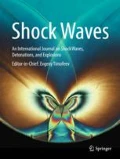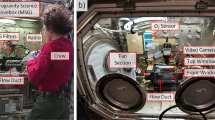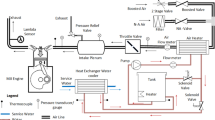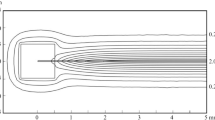Abstract
A rapid compression machine (RCM) and a shock tube (ST) have been employed to study ignition delay times of homogeneous methane/air mixtures at intermediate-to-high temperatures. Both facilities allow measurements to be made at temperatures of 900–2000 K, at pressures of 0.38–2.23 MPa, and at equivalence ratios of 0.5, 1.0, and 2.0. In ST experiments, nitrogen served as a diluent gas, whereas in RCM runs the diluent gas composition ranged from pure nitrogen to pure argon. Recording pressure, UV, and visible emissions identified the evolution of chemical reactions. Correlations of ignition delay time were generated from the data for each facility. At temperatures below 1300 K, a significant reduction of average activation energy from 53 to 15.3 kcal/mol was obtained. Moreover, the RCM data showed significant scatter that dramatically increased with decreasing temperature. An explanation for the abnormal scatter in the data was proposed based on the high-speed visualization of auto-ignition phenomena and experiments performed with oxygen-free and fuel-free mixtures. It is proposed that the main reason for such a significant reduction of average activation energy is attributable to the premature ignition of ultrafine particles in the reactive mixture.













Similar content being viewed by others
References
Seery, D.J., Bowman, C.T.: An experimental and analytical study of methane oxidation behind shock waves. Combust. Flame 14(1), 37–47 (1970)
Lifshitz, A., Scheller, K., Burcat, A., Skinner, G.B.: Kinetics of methane oxidation. Combust. Flame 16, 311–321 (1971)
Tsuboi, T., Wagner, H.G.: Homogeneous thermal oxidation of methane in reflected shock waves. Proc. Combust. Inst. 15, 883–890 (1975)
Walker, D.W., Diehl, L.H., Strauss W.A., Edse R.: Investigation of ignition properties of flowing combustible gas mixtures. In: USAF Report No. AFAPL-TR-69-82 (1969)
Grillo, A., Slack, M.W.: Shock tube study of ignition delay times in methane–oxygen–nitrogen–argon mixtures. Combust. Flame 27, 377–381 (1976)
Cheng, R.K., Oppenheim, A.K.: Autoignition in methane–hydrogen mixtures. Combust. Flame 58, 125–139 (1984)
Spadaccini, L., Colket, M.: Ignition delay characteristics of methane fuels. Progr. Energy Combust. Sci. 20, 431–460 (1994)
Petersen, E.L., Röhrig, M., Davidson, D.F., Hanson, R.K., Bowman, C.T.: High-pressure methane oxidation behind reflected shock waves. Proc. Combust. Inst. 26, 799–806 (1996)
Petersen, E.L., Davidson, D.F., Hanson, R.K.: Ignition delay times of ram accelerator CH\(_4\)/O\(_2\)/diluent mixtures. J. Prop. Power 15(1), 82–91 (1999)
Petersen, E.L., Davidson, D.F., Hanson, R.K.: Kinetics modeling of shock-induced ignition in low-dilution CH\(_4\)/O\(_2\) mixtures at high pressures and intermediate temperatures. Combust. Flame 117, 272–290 (1999)
Gurentsov, E.V., Divakov, O.G., Eremin, A.V.: Ignition of multicomponent hydrocarbon–oxygen mixtures behind shock waves. High Temp. 40(3), 379–386 (2002)
Goy, C.J., Moran, A.J., Thomas, G.O.: Auto-ignition characteristics of gaseous fuels at representative gas turbine conditions. In: ASME Paper 2001-GT-0051 (2001)
Huang, J., Hill, P.G., Bushe, W.K., Munshi, S.R.: Shock-tube study of methane ignition under engine-relevant conditions: experiments and modeling. Combust. Flame 136, 25–42 (2004)
Petersen, E.L., Hall, J.M., Smith, S.D., De Vries, J., Amadio, A., Crofton, M.W.: Ignition of lean methane-based fuel blends at gas turbine pressures. J. Eng. Gas Turbines Power 129, 937–944 (2007)
De Vries, J., Petersen, E.L.: Autoignition of methane-based fuels under gas turbine conditions. Proc. Combust. Inst. 31, 3163–3171 (2007)
Zhukov, V.P., Sechenov, V.A., Starikovskii, A.Yu.: Spontaneous ignition of methane-air mixtures in a wide range of pressures. Combust. Explos. Shock Waves 39(5), 487–495 (2003)
Brett, L., Macnamara, J., Musch, P., Simmie, J.M.: Simulation of methane auto-ignition in a rapid compression machine with creviced pistons. Combust. Flame 124, 326–329 (2001)
Gersen, S., Anikin, N.B., Mokhov, A.V., Levinsky, H.B.: Ignition properties of methane/hydrogen mixtures in a rapid compression machine. Int. J. Hydrogen Energy 33, 1957–1964 (2008)
Heyne, S., Roubaud, A., Ribaucour, M., Vanhove, G., Minetti, R., Favrat, D.: Development of a natural gas reaction mechanism for engine simulations based on rapid compression machine experiments using a multi-objective optimisation strategy. Fuel 87(13–14), 3046–3054 (2008)
Konnov, A. A.: Detailed reaction mechanism for small hydrocarbons combustion (version 0.5). (2000)
Gas Research Institute reaction mechanism (GRI Mech, version 3.0). http://www.me.berkeley.edu/gri-mech/. Accessed 11 Sept 2013
Petersen, E.L., Kalitan, D.M., Barret, A.B., Reehal, S.C., Mertens, J.D., Beerer, D.J., Hack, R.L., McDonell, V.G.: New syngas/air ignition data at lower temperature and elevated pressure and comparison to current kinetic models. Combust. Flame 149, 244–247 (2007)
Chaos, M., Dryer, F.L.: Chemical-kinetic modeling of ignition delays: considerations in interpreting shock tube data. Int. J. Chem. Kinet. 42(3), 143–150 (2010)
Dryer, F.L., Chaos, M.: Ignition of syngas/air and hydrogen/air mixtures at low temperatures and high pressures: experimental data interpretation and kinetic modeling implications. Combust. Flame 152, 293–299 (2008)
Pang, G.A., Davidson, D.F., Hanson, R.K.: Experimental study and modeling of shock tube ignition delay times for hydrogen–oxygen–argon mixtures at low temperatures. Proc. Combust. Inst. 32, 181–188 (2009)
Chaos, M., Dryer, F.L.: Syngas combustion kinetics and applications. Combust. Sci. Tech. 180, 1053–1095 (2008)
Leschevich, V.V., Penayzkov, O.G.: Auto-ignition of microparticles as a mechanism for RCM combustion. In: Proceedings of the 24th ICDERS (2013)
Elsworth, J.E., Haskel, W.W., Read, J.A.: Non-uniform ignition processes in rapid-compression machines. Combust. Flame 13(4), 437–438 (1969)
Walton, S.M., He, X., Zigler, B.T., Wooldridge, M.S., Atreya, A.: An experimental investigation of iso-octane ignition phenomena. Combust. Flame 150, 246–262 (2007)
Tropin, D.A., Fedorov, A.V., Penyazkov, O.G., Leshchevich, V.V.: Ignition delay time in a methane–air mixture in the presence of iron particles. J. Combust. Explos. Shock Waves 50(6), 632–640 (2014)
Livengood, J.C., Leary, W.A.: Autoignition by rapid compression. Ind. Eng. Chem. 43(12), 2797–2805 (1951)
Author information
Authors and Affiliations
Corresponding author
Additional information
Communicated by L. Bauwens.
Rights and permissions
About this article
Cite this article
Leschevich, V.V., Martynenko, V.V., Penyazkov, O.G. et al. Auto-ignitions of a methane/air mixture at high and intermediate temperatures. Shock Waves 26, 657–672 (2016). https://doi.org/10.1007/s00193-016-0665-9
Received:
Revised:
Accepted:
Published:
Issue Date:
DOI: https://doi.org/10.1007/s00193-016-0665-9




